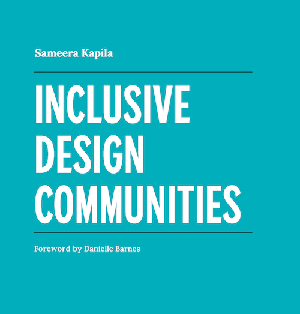A review of

Inclusive Design Communities
A Book Apart
147 pages, 6 chapters
About this book
by Sameera Kapila
A good reference for Methods/How-To
Primary audience: Researchers, designers, and technical roles who are new to the topic, have some experience with the topic, or have significant experience with the topic
Writing style: Matter of fact
Text density: Mostly text
Learn more about our book review guidelines
Sameera Kapila’s Inclusive Design Communities offers a concise and pragmatic primer on privilege and marginalization in the workplace and how to address the gaps between them. She handles topics that can feel prickly and uncomfortable with a matter-of-factness and aplomb that feels accessible to any reader. At 130 pages (not counting the acknowledgements and references), this book is a quick read.
In six short chapters, Kapila defines inclusion, identity, and marginalization, and she gives us clear instructions for transforming design education, hiring practices, and workplace culture. Chapter 1, “Understanding Inclusion,” is dedicated to definitions of the many kinds of exclusions that take place at work either intentionally or unintentionally. Kapila includes relatable examples here and throughout the book, including mistakes she has made in her own career. As Kapila describes the differences between a designer’s intent and their impact, she discusses a failure of her own—a case of unintentionally adding hurdles that she intended to remove. In her attempt to help financially disadvantaged students receive aid to attend a school for coding, she created a longer, separate application form to understand their needs. Unfortunately this form created more work for students who were already starting behind their peers (page 15). Kapila’s honest reckoning with her own gap between intention and impact demonstrates the kind of openness and learning she advocates for.
In Chapter 2, “Expanding Mind and Action,” she digs deeper into the growth mindset required to remove barriers in the workplace. Kapila points out that staying in our comfort zones only reinforces our biases, whereas real change is uncomfortable and requires us to confront our motivations. She provides guides and checklists for helping us to become aware of our own biases and for improving our decision-making. For instance, Kapila recommends we pause before reacting to others, listen to their input, and interrogate our own motivations and judgements (page 28). Owning our mistakes and thoughtfully taking action are the way to make a workplace a safe and equitable space for all people.
Chapter 3 is an examination of the biases perpetuated in design education and how to address them. Kapila discusses the over-reliance on Eurocentric and white male writing on design history, the challenges of curriculum reform, and alternative paths to design roles that do not follow the four-year college model. A short list of resources to “diversify design education” (pages 44-45) is helpful to design educators like me, but the section “Empowered Classrooms” (pages 48-54) is an excellent source of strategies and tactics to meet students where they are and empower them on their individual learning journeys.
Chapter 4, “Transforming Hiring Practices and Leading Inclusive,” and Chapter 5, “Leading Inclusivity in the Workplace,” are the core chapters where we learn about how to make work equitable for all kinds of people. These key sections cover the entire employee lifecycle, starting with writing better job descriptions through exit interviews. Kapila describes how to use our design skills to map the hiring process, unbiasing recruitment, salary transparency, benefits that match employees’ needs, and processing feedback when employees leave. Here we also find advice for mentors and managers as well as a crucial section, “When issues arise” (pages 100-102). The burden is on those in positions of power to step up and speak up for those who cannot without fear of being ignored or outright retribution.
“Simply telling teammates to move diversity efforts forward is not enough; coworkers will need to see their managers and C-level executives take action. As a manager myself, I believe managers—especially senior leadership—are 99 percent responsible for making their company inclusive” (page 97).
Rather than feeling prescriptive or rigid, these chapters read more like step-by-step therapy for improving the health of any workplace.
It should be noted that, apart from a chapter on design education and examples of the unintended consequences of design decisions, none of Kapila’s guidance is specific to design communities. Anyone looking for advice on practicing inclusive design should perhaps look to Senongo Akpem’s Cross-Cultural Design. Akpem covers the principles of cross-cultural design, including unbiasing our preexisting knowledge, understanding cultural differences, conducting research, and designing experiences for all kinds of peoples.
Inclusive Design Communities is a useful handbook for any employee working toward safer spaces at work, although it is really directed at the co-workers of marginalized people. There is some advice for those on the receiving end of bias in Chapter 5, like finding an ally, raising issues, and going to human resources for help. However, Kapila is largely speaking to employees in positions of power or people living with privilege they may not be aware of. In the right hands, this guide could be a very powerful changemaker at work.
“Simply telling teammates to move diversity efforts forward is not enough; coworkers will need to see their managers and C-level executives take action. As a manager myself, I believe managers—especially senior leadership—are 99 percent responsible for making their company inclusive.” – Sameera Kapila
Sarah Pagliaccio is an educator and UX consultant working at the intersection of tech, the arts, and humanness. Sarah believes computer-human interactions should be characterized by transparency and dignity. That is the message she strives for in her design work, writing, and teaching at Bentley University.


User Experience Magazine › Forums › Building Belonging in Every Workplace (Book Review)